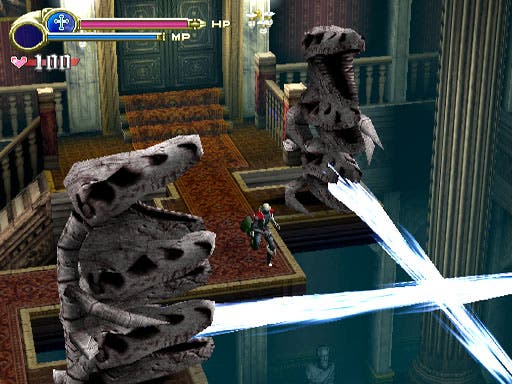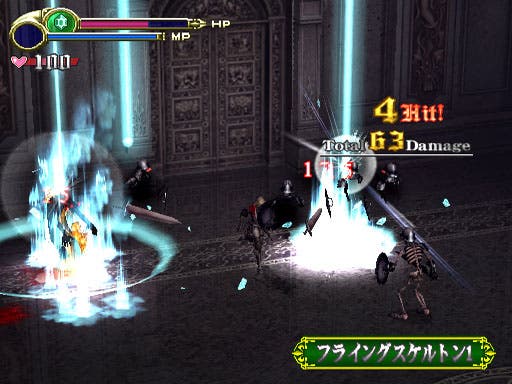ECTS 2003: Castlevania: Lament of Innocence
Rob mixes with the undead in full 3D.
If we were to write up a rule-book for game designers, somewhere in the massive tome you'd almost certainly find the following entry; "Thou shalt not try to make Castlevania in 3D". After a couple of abortive attempts on the N64 - which created competent enough third-person games, but utterly failed to capture the atmosphere or replicate the slick gameplay of the 2D incarnations of the series - followed by a successful return to 2D with a number of excellent GBA titles, Konami has decided to revisit the concept of a 3D Castlevania title - and this time, they might just have got it right.
Whip me harder

The essence of Castlevania isn't that dissimilar from the concept behind the 2D Metroid games - they're free-roaming platformers with a hefty wodge of adventuring and exploration as their key hooks. As the game progresses, you acquire new abilities and revisiting previously completed areas with your new powers at hand tends to open up fresh possibilities. This is the gameplay mechanic which Metroid Prime hugely successfully converted into 3D - in the case of Castlevania, the gameplay also features a fair dose of magical powers and RPG-style levelling up (introduced in the seminal Symphony of the Night, from which most Castlevania games now take their direct inspiration).
Playing Lament of Innocence reveals that most of the key elements of the game are present and correct. The sinister but ornately decorated castle, the moody-looking hero wielding a vicious whip, the dramatic orchestral soundtrack, and the legions of the undead and the damned all keen to tear you to shreds in defence of their vampire lord... Yes, this is familiar territory indeed. Perhaps more importantly, basic systems like using hearts for activating magical powers (and collecting further hearts by breaking vases and lamps), collecting magical weapons which replace the one you currently hold, and even (we think) the experience system are all right there.
The only major difference, then, is that the game is now played in 3D - and that, admittedly, is a very big change. As you run from room to room in the castle, you're followed by a generally fixed-angle camera, which works remarkably well and almost always shows you the best angles on the action - although we did notice it getting confused during boss battles sometimes. Your character has a range of whip attacks at his disposal, which can be used to dispatch the damned, along with a new and rather impressive attack where he leaps into the air and brings down a flaming kick on the head of his enemy. Handy in a bar brawl, that.
Interview with a Vampire

On a fundamental level, this 3D interpretation of the gameplay works very well. The rooms we saw were rather basic affairs - corridors and simple chambers - but we assume that it all gets more complex later on, just as Castlevania castles are wont to do. How well the control scheme will work in rooms as complex as the clock towers (with their giant moving gears) or the Towers of Magic and Science remains to be seen, but we do hope that the team hasn't chosen to ditch these environments, which have formed a part of Castlevania for years. Defeating basic enemies is quite good fun - the gameplay is reminiscent of a cross between Sega's recent Shinobi remake and Capcom's Devil May Cry, although based on our short bash at the game it's head and shoulders above either of those (particularly the lamentably bad Shinobi).
It's when you reach a boss that the gameplay comes into its own, and the boss we battled was suitably impressive - a giant stone golem which had a variety of tricky attacks. Like most Castlevania bosses, there's a simple way to defeat him if you work out what pattern he moves in, so the battle happily doesn't boil down to a simple war of attrition. It also gives the hero a chance to show off plenty of cool-looking jumps and attacks, and it encouraged us to take a peek at one new system introduced in Lament of Innocence - namely coloured magical orbs which enhance your special weapons in unique ways.
This system takes the form of a ring activated by one of the triggers, allowing you to switch colours easily. We found ourselves in possession of red and blue orbs, which changed the behaviour of our special weapon (a type of explosive crystal that can be dropped behind you) significantly. Under the influence of the red orb, activating the special weapon caused a huge crystal to engulf your enemy and explode; with the blue one equipped instead, a series of crystals slammed into the ground around the player, causing damage to anyone nearby. It's a clever system which should provide a wide range of different gameplay options, and hours of experimentation with the different weapons.
Questions, questions

Ultimately, however, Castlevania has never just been about the minute-to-minute gameplay. Lament of Innocence certainly has that right, and the environments and atmosphere also feel right (although that's a tough thing to judge when standing on a trade show floor); however, we were a little concerned that we saw no sign of an overall map screen, and that the areas we passed through had only one entrance and one exit each.
Admittedly we only played a small demo section of the game, but the really big question here is whether the final game will maintain the basis of Castlevania's gameplay - exploration, upgrading and more exploration, with the reward for each completed section being an upgrade that allows you to open up more aspects of earlier parts of the game. We can't imagine that Konami's designers would have left this element out, but it's a bit of a shame that we didn't get to see it in action.
All in all, though, our hands-on impressions of the game from ECTS compound the good feeling we got from its showing at E3 back in May. Konami may have finally worked out how to translate Castlevania into 3D, and if so, we can't wait to explore Dracula's citadel in the gloriously designed form on offer in Lament of Innocence. Perhaps it's time for a revision to our rulebook.

